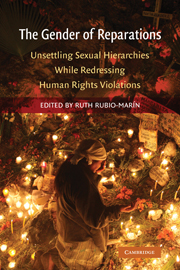Book contents
- Frontmatter
- Contents
- Acknowledgments
- Contributors
- Photo Credits: “Gender, Memorialization, and Symbolic Reparations,” in The Gender of Reparations
- International Center for Transitional Justice (ICTJ)
- Introduction: A Gender and Reparations Taxonomy
- 1 Gender and Violence in Focus: A Background for Gender Justice in Reparations
- 2 The Gender of Reparations in Transitional Societies
- 3 Reparation of Sexual and Reproductive Violence: Moving from Codification to Implementation
- 4 Reparations as a Means for Recognizing and Addressing Crimes and Grave Rights Violations against Girls and Boys during Situations of Armed Conflict and under Authoritarian and Dictatorial Regimes
- 5 Repairing Family Members: Gross Human Rights Violations and Communities of Harm
- 6 Tort Theory, Microfinance, and Gender Equality Convergent in Pecuniary Reparations
- 7 Gender, Memorialization, and Symbolic Reparations
- 8 Gender and Collective Reparations in the Aftermath of Conflict and Political Repression
- Index
- References
5 - Repairing Family Members: Gross Human Rights Violations and Communities of Harm
Published online by Cambridge University Press: 25 August 2009
- Frontmatter
- Contents
- Acknowledgments
- Contributors
- Photo Credits: “Gender, Memorialization, and Symbolic Reparations,” in The Gender of Reparations
- International Center for Transitional Justice (ICTJ)
- Introduction: A Gender and Reparations Taxonomy
- 1 Gender and Violence in Focus: A Background for Gender Justice in Reparations
- 2 The Gender of Reparations in Transitional Societies
- 3 Reparation of Sexual and Reproductive Violence: Moving from Codification to Implementation
- 4 Reparations as a Means for Recognizing and Addressing Crimes and Grave Rights Violations against Girls and Boys during Situations of Armed Conflict and under Authoritarian and Dictatorial Regimes
- 5 Repairing Family Members: Gross Human Rights Violations and Communities of Harm
- 6 Tort Theory, Microfinance, and Gender Equality Convergent in Pecuniary Reparations
- 7 Gender, Memorialization, and Symbolic Reparations
- 8 Gender and Collective Reparations in the Aftermath of Conflict and Political Repression
- Index
- References
Summary
INTRODUCTION
Many of the forms of violence committed under authoritarian regimes and during large-scale ethnic and civil strife target individuals for reasons such as their political activities, ethnicity, race, and religion. It is individual persons who find their most fundamental human rights violated when subjected to prolonged detention and torture, extrajudicial killings, disappearance, sexual violence, amputation, and forced recruitment and displacement. However, beyond individuals, these violations create communities of harm that include all of those people emotionally tied to the victims or in a relationship of codependency with them. Parents, partners, spouses, children, and siblings are often left both emotionally desolate and economically destitute. In other words, the violence affects not only the targeted individual but also his or her family members. A relevant question becomes, then, whether and how this fact has been or can be acknowledged in reparations initiatives.
Clearly, determining the “family members” who, as such, are entitled to reparations depends on the definition of “victim,” and that in turn depends on which violations are considered to be grave or gross violations of human rights that trigger reparations in the first place. Although both national nonjudicial reparations programs and international human rights adjudicatory bodies have thus far privileged violations of civil and political rights that in many contexts are disparately committed against men (such as disappearances, illegal detention, torture, and extrajudicial killing), many of those who could potentially be included – depending on whether the reparations scheme is sensitive to the impact of violence on the family and to the fact of human interdependency – are in fact women and children.
- Type
- Chapter
- Information
- The Gender of ReparationsUnsettling Sexual Hierarchies while Redressing Human Rights Violations, pp. 215 - 290Publisher: Cambridge University PressPrint publication year: 2009
References
- 2
- Cited by



